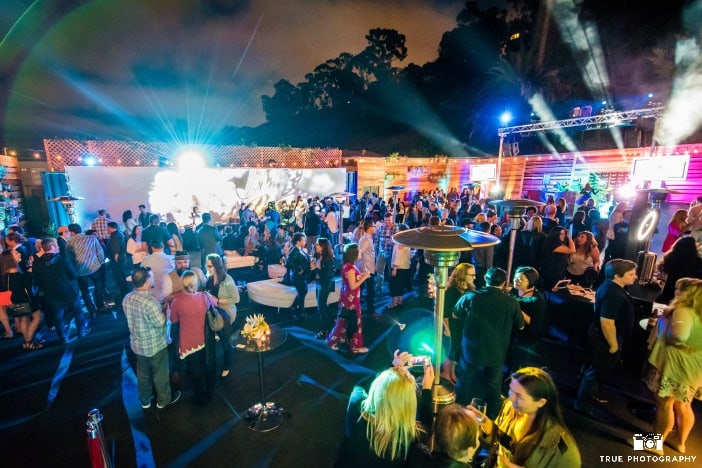In the past, a reliable internet connection was limited to your home office. In 2020, you can get online from just about anywhere. In turn, internet connection has become integral to the way our society functions. People simply expect WiFi everywhere they go.
There’s nothing more frustrating than finding yourself at an event without WiFi. Yet unfortunately, at large, crowded events, WiFi is notoriously unreliable. That’s because many events fail to prepare for the high demands placed on their WiFi network. You’d be surprised how many things out there can interfere with WiFi signals and event technology.
Let’s delve into what causes WiFi interferences, how phones affect WiFi, and explain how to prevent them at your next event.
What Are the Signs of Wifi Signal Interference?
If you’re experiencing WiFi troubles at an event, there’s a good chance that signal interference is to blame. Here are some signs of signal interference:
- Poor signal strength
- A slow internet connection
- Slow data transfer
- Pairing difficulties between Bluetooth devices
- Dropped WiFi connections
You’ve probably dealt with some of these issues first-hand. As you know, they can be incredibly frustrating. If you’re an event organizer, these WiFi snafus can be a serious mood killer for your attendees. They don’t want to feel like they’ve entered the dark ages just because they came to your event.
So what’s causing these issues and how can they be fixed? Let’s take a look.
What Interferes With WiFi?
WiFi signal interference has two main causes: physical barriers and frequency interferences.
Both may be contributing to the problem, depending on the elements of your event venue. Review the following causes of interference to pinpoint exactly what’s behind your event’s WiFi interruptions.
Physical WiFi Signal Interferences
Certain building materials are notorious for interfering with WiFi connections. Concrete is a common culprit.
If you’ve ever entered a concrete parking garage, you’ve probably experienced this problem. As soon as you drive into the garage, you lose your WiFi connection. This type of signal interference is caused by a physical barrier.
Metal is the material with the greatest interference potential. However, brick and concrete are close behind. Water is another source of signal interference, so look out for any large water features or fish tanks at your venue. Wood, glass, and other synthetic materials are the least likely to cause a notable interference.
Frequency WiFi Signal Interferences
Another common cause of poor WiFi is frequency interference. This takes place when other electromagnetic signals get in the way of your WiFi signal. There are several devices that emit electromagnetic signals, such as:
- Smartphones
- Wireless speakers
- Wireless video cameras
- Walkie talkies
- Microwave ovens
- Hearing aids
- Satellite dishes
- Poorly shielded power lines
If you notice cell phones interfering with 5G events, WiFi, or any of these other devices, try removing them to see if that helps. (Although, if you’re at an event, you can’t exactly ask your attendees to please leave their phones at home.)
In addition to these devices, one of the most frequent reasons for WiFi interference is other WiFi networks in close proximity. For example, you may discover that multiple WiFi signals are competing with each other at your event.
What Causes A Bad Wifi Signal at Events?
In addition to signal interferences, there are a few more WiFi complications to look out for. These are especially common at large, crowded events.
- Overcapacity – At large events, there are oftentimes more attendees trying to connect to the WiFi than there is available capacity. As everyone tries to connect to the network, they create overload issues, since WiFi has a limited capacity of bandwidth. The more people who try to connect to it, the more that bandwidth gets split between people, reducing speed and connectivity for everyone.
- Limited Coverage – WiFi devices must be placed around a venue in specific locations. To enjoy the strongest WiFi signal, you need to be in close proximity to one of these devices. The further you are from a device, the longer the signal will have to travel, and the weaker that WiFi connection will be.
- Mispositioned Routers – The positioning of your wireless router has a big impact on WiFi coverage, since it directs the WiFi signal in a specific direction. Its positioning determines which areas receive WiFi coverage and how strong the signal will be. You want to shoot out the signal in the optimal direction for maximized coverage. Since WiFi signals are invisible, you can’t visually verify that your router is installed correctly—you need to use a specific WiFi-measuring device.
To overcome these issues, make sure that your event is equipped with adequate WiFi coverage from your network provider. Next, optimize that coverage by placing the WiFi routers in the proper direction. A network technician can help ensure proper installation. Finally, keep your router close to the middle of your desired coverage area on an elevated surface. This will provide the best coverage.
How to Prevent WiFi Interruptions At Your Next Event
If you want the next event to go off without a hitch, make sure you have your WiFi coverage in order. Prioritize WiFi from the very start of the planning phases by following these steps:
1. Plan Ahead of Time
Any event planner understands the importance of planning—it’s in the job description. WiFi planning is just as important as hiring the right speaker or decorating the venue. As such, you’ll want to start the process by understanding your audience, their expectations, and the venue’s offerings.
Make sure you know how many people are coming to the event because this will directly impact your WiFi needs. Also, factor in who the attendees are. If your event is inviting high-profile influencers, press, or other people who will require WiFi, make sure they have access to it. Depending on your guest list, you can also predict which type of devices they’ll have in tow that require a WiFi connection.
Next, consider the event’s activities and venue. Most events have spaces where audiences congregate. These high-traffic areas will have higher WiFi demands. Make sure to deliver greater WiFi support to those areas. By properly preparing for your audience’s needs, you’ll avoid the blunder of under-providing critical WiFi services.
2. Choose the Right Network Provider
Once you’ve determined your WiFi needs, reach out to a few wireless network providers and choose the one that can confidently supply adequate coverage and capacity. Even if your venue already has WiFi in place, it may not be enough to handle your event’s demands. If you require additional, temporary WiFi bandwidth, your network provider can help you with that.
Next, invest in the right amount of wireless network equipment. For example, make sure you have enough access points to meet your needs.
Finally, consider hiring on-site technical support to monitor the WiFi throughout the event. This team will have the required knowledge to make adjustments and fix issues as they arise. Their troubleshooting assistance will greatly reduce any potential embarrassing WiFi hiccups.
3. Arrange Event Decor Strategically
As previously explained, some physical structures and frequency-emitting devices can hinder your WiFi performance. Plan your venue accordingly. Reduce the number of signal-emitting devices and pay attention to the building’s materials.
Make sure you consider how the various elements of your event will affect the WiFi signal strength, such as:
- Large art structures
- Vendor booths
- Video production teams
Arrange these features so that they’re less likely to cause interference.
Finally, consider pre-cabling your venue with access points. With that structure in place, you can arrange all future event features accordingly.
4. Set Reasonable Wifi Limitations for Event Attendees
To make sure there is enough WiFi to go around without breaking the bank, it’s okay to place some limitations.
- Bandwidth: A bandwidth limit restricts how much WiFi an individual attendee can use within a given period of time. This will prevent a few people from dominating the WiFi bandwidth, using it all up for themselves. For example, a 200 kbit/per person limit can maintain browsing speeds without allowing excessive bandwidth access.
- Application Usage: You can also restrict WiFi use for specific applications. This will ensure that precious WiFi is reserved for the things that matter most. For example, file-sharing can eat up huge amounts of bandwidth and may not be necessary at your event.
- Access Point Range: Lastly, by limiting the frequency range of each access point, you will improve the overall WiFi connection. This is because smaller access point ranges create an improved network distribution, as they force attendees to use the access point nearest to them.
By planning ahead, being strategic, and by seeking the help of a network engineer, your event will boast the best WiFi your guest list has ever seen.
Wave Goodbye to WiFi Interferences At Your Next Event
After putting so much effort into an event, from the design to the entertainment, don’t let poor WiFi ruin the experience for your guests. By properly planning your WiFi strategy before the event, you’ll avoid interference issues. Just make sure you acquire adequate WiFi capacity and coverage for your chosen venue and audience size.
To learn more about how to put on an outstanding event, reach out to Vario to handle all of your event technology needs.







